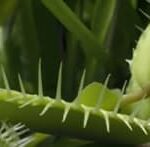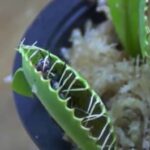As an Amazon Associate, this site earns commissions from qualifying purchases. For more details, click here.
There are few things more alarming than seeing your Venus flytrap suffer root rot. This is quite a common issue for beginners and can cause serious problems if not handled properly. Fortunately there are ways to prevent this from happening.
Root rot in Venus flytraps is caused by too much water, causing the root to turn reddish brown and mushy. This can be prevented by keeping the soil moist, not soggy.
What Do Healthy Venus Flytrap Roots Look Like?
First we have to know what healthy Venus flytrap roots are supposed to look like. Otherwise it will be impossible to tell if there is something wrong.
The bulb (rhizome) of a Venus flytrap is usually white with a bit of pink around the edges. The roots are somewhat flimsy even if healthy, but they should not be mushy.
You will see some black strands in the roots and that is normal. If the Venus flytrap gets enough nutrients, the roots would have these characteristics. Most of these plants grow 4-5 inches long, but some only have 3 inch roots.
Short roots is not indicative of poor health or rot. With proper care they will grow just like other healthy Venus flytraps.
The root structure is basic, growing down and spreading. Five inches is the average size but this can vary depending on how healthy the plant is.
As long as the roots are mostly white, there should be no problems. With sufficient watering the roots will also be moist, the consistency you should strive for.
Venus Flytrap Root Rot Causes and Symptoms
The most common cause of root rot is too much water. Venus flytraps need water to survive just like other plants, but it is easy to overdo this.
The rule is to keep the soil moist, not soggy. If the plant is drenched in water, it becomes prone to bacterial infection. When infection sets in, the root starts to turn reddish brown before decaying completely.
Signs of root rot include:
- Blackish spots in the bulb indicate rot has begun. This may be accompanied by a foul smell which permeates throughout the roots. This is uncommon but can occur.
- Healthy Venus flytraps have colorful leaves and lobes. The trigger hairs in the traps are straight and the traps are very responsive. If the leaves lose their color and the traps appear unhealthy, those are signs of root rot.
- One way to prevent root rot is ensure your Venus flytrap receives enough nutrients. Regular feeding plus sunlight are required so the plant will have sufficient energy even if there are limited insects around.
While too much water is the most common cause, there are other possible culprits. An unhealthy Venus flytrap will always be vulnerable to root rot, bacterial infections and foul smelling poop.
Venus flytraps need 12 hours of sunlight. Without the sun the plant will not be able to photosynthesize and create food. Ants, gnats, and other insects are not substitutes for sunlight because Venus flytraps need them for energy, not food which comes from the sun.
Venus flytraps also need 3-5 months of dormancy. The lack of it weakens the immune system and makes it vulnerable to bacteria.
As long as your Venus flytrap is being fed properly with enough sunlight, it should be safe from root rot. But if rot does happen, follow these steps to remedy the situation.
How to Remove Venus Flytrap Root Rot
If your Venus flytrap exhibits any of the signs above, it is not completely over. Try these steps to keep the rest of your Venus flytrap alive.
- Carefully take the Venus flytrap off the pot. Chances are the soil is too mushy so it should be easy. Be careful nonetheless. Use garden scissors or pruning shears to cut the rotted areas.
- Prepare new soil consisting of equal parts sphagnum moss and sand. Our choice is Perfect Plants Carnivorous Plant Soil. Repot the Venus flytrap, again checking if there are any rotting parts.
- Water the Venus flytrap. Again make sure that the soil is moist but not too wet. The soil should feel moist but it should not be immersed in water. With Sonkir Soil PH Meter it is easy to check the soil moisture level.
Venus flytraps should be placed in an 8 inch deep pot. While its roots are usually 5 inches long, a deeper pot is ideal so the plant can breathe.
If you have several Venus flytraps, keep them some distance apart. Plants too close together are prone to bacterial infections which you should avoid.
Once the plant has been potted, place it in a well lit location. For outdoor Venus flytraps make sure it gets about 8-12 hours of sunshine, and for indoors 13 hours of incandescent light.
If your Venus flytrap is recovering from root rot, place it outdoors for maximum sunlight. There is no need to give it any more food since there are insects its traps can feed on.
If you see some black root strands start to appear, that is normal. The key thing is to ensure the rhizome remains mostly white.
How to Avoid Venus Flytrap Root Rot
Make sure the soil has long sphagnum moss and sand or perlite. What is important is to add either of the two to the sphagnum moss. This results in better aeration and allows air and water to flow. All this helps Venus flytraps fend off root rot.
The easiest way to prevent Venus flytrap root rot is to keep the soil wet, not soggy. Do not let the soil dry out but do not let it get too mushy.
Do not stick to a permanent watering schedule. Venus flytraps will need more water during the summer and less so during the cool season. The hotter it is, the more water is required. Reduce the watering when the temperature drops.
Water evaporates faster when it is hot so frequent refilling is likely. During fall, most of the liquid will remain in the soil so keep an eye on it. If the soil is still moist there is no need to add more water.
You are probably wondering if Venus flytraps will really die from too much water. If the plant is healthy it should be fine, but why take the risk? You will get a better looking and healthier traps if you water appropriately.
Watering is always important, but even more so if your Venus flytrap is still young. Its roots are still vulnerable and you need to make certain the soil does not become ripe for bacteria.
Why Too Much Water Causes Root Rot
Venus flytraps in the wild usually grow in grasslands. Some of these plants can thrive in bogs and swamps, which leads some to believe they are aquatic carnivorous plants.
No matter how Venus flytraps reproduce, they will be prone to bacteria if the soil is too wet. Without perlite or sand, bacteria will thrive and get into the roots.
The fact is Venus flytraps need plenty of water, but not too much. Do not put a Venus flytrap in a bowl of water or leave it submerged. As long as the soil is not dry that is enough.
Dormant Venus flytraps need even less, about every 8-15 days of watering is enough. When the plant emerges again in spring, you can slowly increase the watering frequency.
The last part is especially important. During dormancy, Venus flytraps shrink and discard their leaves. It looks as if the plant has died and people tend to overwater it.
Just let the plant go into dormancy mode and water in the manner described above. Do not water it every two days as it might kill the plant or contribute to root rot.
Conclusion
If you go to online forums there are plenty of Venus flytrap owners who have had to deal with root rot. By following the advice given here, hopefully you will not have to deal with it, and if it does happen you know what to do.

My fascination with carnivorous plants began many, many years ago with Venus Fly Traps. Now I am more than happy to impart what I know with other enthusiasts and those who are curious about meat eating plants.



